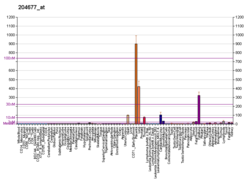Top Qs
Timeline
Chat
Perspective
VE-cadherin
Protein-coding gene in the species Homo sapiens From Wikipedia, the free encyclopedia
Remove ads
Cadherin-5, or VE-cadherin (vascular endothelial cadherin), also known as CD144 (Cluster of Differentiation 144), is a type of cadherin. It is encoded by the human gene CDH5.[5]
Remove ads
Function
Summarize
Perspective
VE-cadherin is a classical cadherin from the cadherin superfamily and the gene is located in a six-cadherin cluster in a region on the long arm of chromosome 16 that is involved in loss of heterozygosity events in breast and prostate cancer. The encoded protein is a calcium-dependent cell–cell adhesion glycoprotein composed of five extracellular cadherin repeats, a transmembrane region and a highly conserved cytoplasmic tail. Functioning as a classic cadherin by imparting to cells the ability to adhere in a homophilic manner, the protein may play an important role in endothelial cell biology through control of the cohesion and organization of the intercellular junctions.[6]
Integrity of intercellular junctions is a major determinant of permeability of the endothelium, and the VE-cadherin-based adherens junction is thought to be particularly important. VE-cadherin is known to be required for maintaining a restrictive endothelial barrier – early studies using blocking antibodies to VE-cadherin increased monolayer permeability in cultured cells[7] and resulted in interstitial edema and hemorrhage in vivo.[8] A recent study has shown that TNFAIP3 (A20, a dual-ubiquitin editing enzyme) is essential for stability and expression of VE-cadherin. Deubiquitinase function of A20 was shown to remove ubiquitin chains from VE-cadherin, thereby prevented loss of VE-cadherin expression at the endothelial adherens junctions.[9]
VE-cadherin is indispensable for proper vascular development – there have been two transgenic mouse models of VE-cadherin deficiency, both embryonic lethal due to vascular defects.[10][11] Further studies using one of these models revealed that although vasculogenesis occurred, nascent vessels collapsed or disassembled in the absence of VE-cadherin.[12] Therefore, it was concluded that VE-cadherin serves the purpose of maintaining newly formed vessels.
Remove ads
Interactions
VE-cadherin has been shown to interact with:
As a biomarker
VE-cadherin may serve as a biomarker for radiation exposure.[20]
See also
References
Further reading
External links
Wikiwand - on
Seamless Wikipedia browsing. On steroids.
Remove ads





